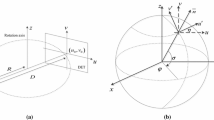Abstract
X-ray digital tomosynthesis (DT) is very useful to PCB inspection because it can obtain a cross-sectional image of a local inspection area quickly. The image intensifier, which is usually used in DT, distorts X-ray images in shape and intensity. Therefore, image distortion correction is one of the most important issues in realizing DT system. In this paper, two image distortion correction methods for an X-ray DT system are presented and their performances are compared. The first method is to use a simplified distortion model by a distance ratio function in intensity correction, and by 2D point mapping polynomials in shape correction. The second method is to use a general polynomial distortion model. The experimental results show a great improvement of the second method in compensation speed and accuracy.
Preview
Unable to display preview. Download preview PDF.
Similar content being viewed by others
References
Adams, J.: X-ray laminography analysis of ultra fine pitch solder connections on ultra-thin boards. In: SPIE Integrated Circuit Metrology, Inspection, and Process Control V, vol. 1464, pp. 484–497 (1991)
Bossi, R.H., Georgeson, G.E.: Casting development savings with X-ray computed tomography. Casting, 181–188 (1993)
Bocage, E.M.: French Patent 536464 (1922)
Rooks, M., Sack, T.: X-ray inspection of flip chip attach using digital tomosynthesis. In: Surface Mount Int. Conf., San Jose, pp. 51–55 (1994)
Bord, S., Clement, A., Lecomte, J.C., Marmeggi, J.C.: An X-ray tomography facility for IC industry at STMicroelectronics Grenoble. Microelectronic engineering 62, 1069–1075 (2002)
Sumimoto, T., Maruyamay, T., Azuma, Y., Goto, S., Mondo, M., Furukawa, N., Okada, S.: Detection of defects at BGA solder joints by using X-ray imaging. In: 2002 IEEE Int. Conf. on Industrial Technology, vol. 1, pp. 238–241 (2002)
Roh, Y.J., Ko, K.W., Cho, H.S., Kim, J.Y., Byun, J.E.: The calibration of X-ray digital tomosynthesis system including the compensation of the image distortion. In: SPIE Symp. on Intelligent Systems and Advanced Manufacturing VII, vol. 3528, pp. 248–259 (1998)
Author information
Authors and Affiliations
Editor information
Editors and Affiliations
Rights and permissions
Copyright information
© 2005 Springer-Verlag Berlin Heidelberg
About this paper
Cite this paper
Kim, J.Y. (2005). Comparison of the Image Distortion Correction Methods for an X-Ray Digital Tomosynthesis System. In: Kamel, M., Campilho, A. (eds) Image Analysis and Recognition. ICIAR 2005. Lecture Notes in Computer Science, vol 3656. Springer, Berlin, Heidelberg. https://doi.org/10.1007/11559573_36
Download citation
DOI: https://doi.org/10.1007/11559573_36
Publisher Name: Springer, Berlin, Heidelberg
Print ISBN: 978-3-540-29069-8
Online ISBN: 978-3-540-31938-2
eBook Packages: Computer ScienceComputer Science (R0)




